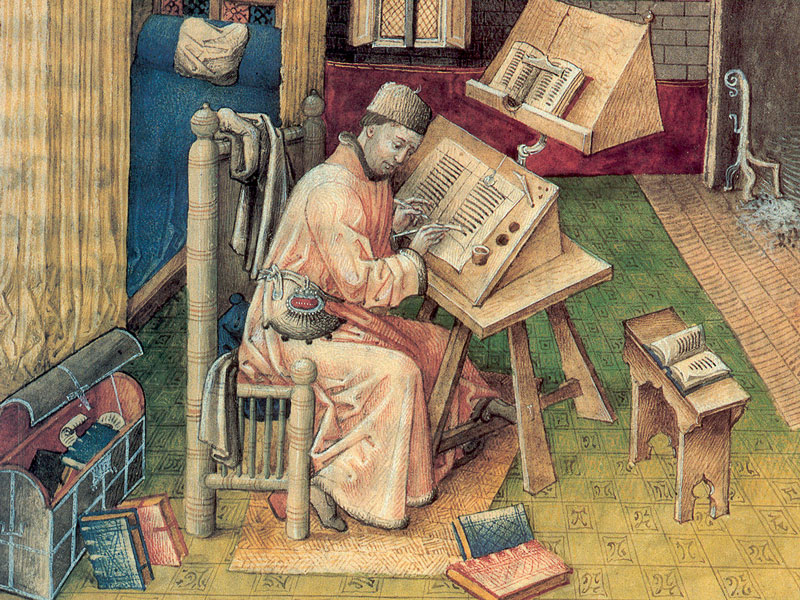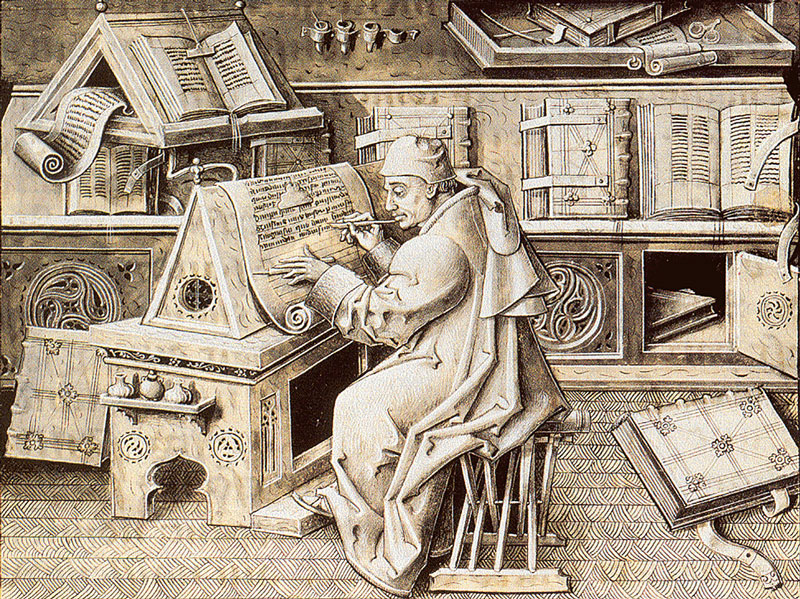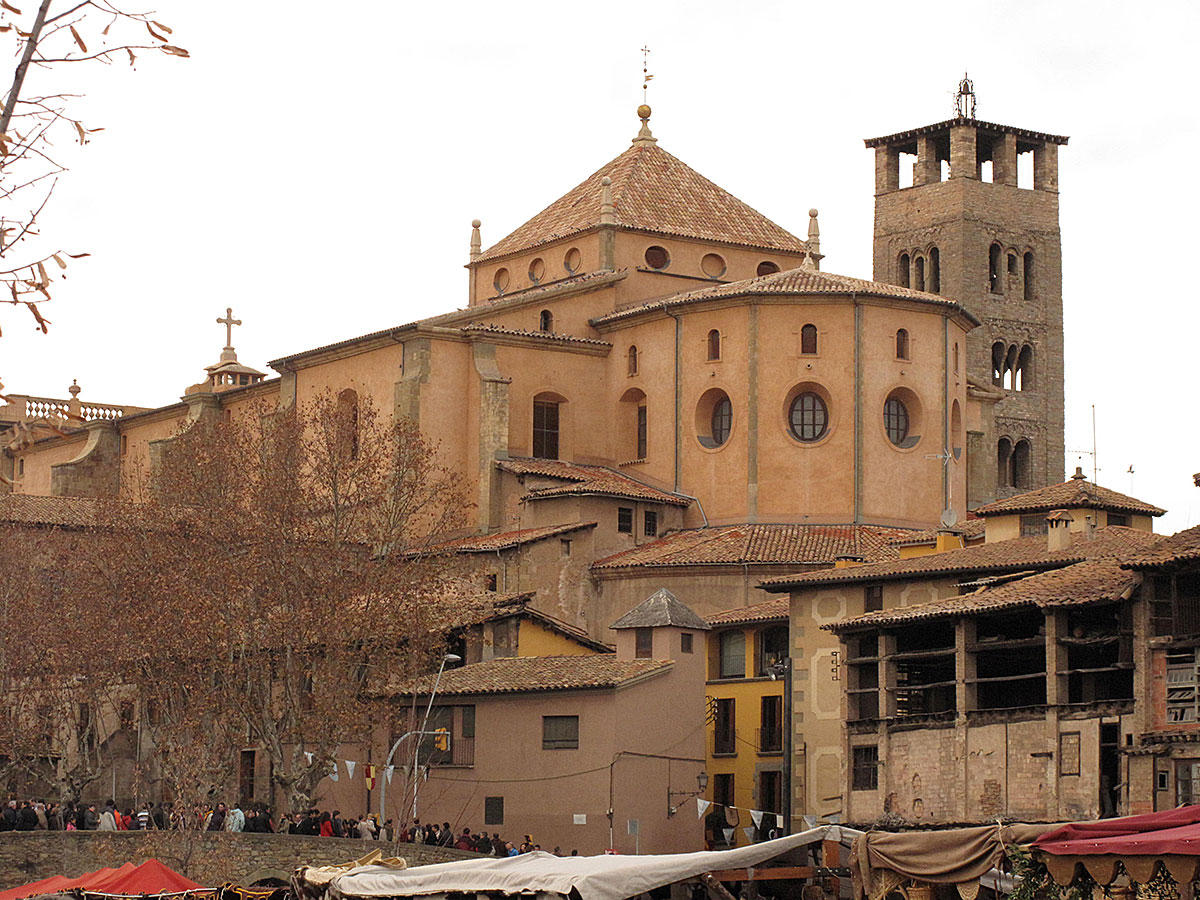
Medieval manuscripts
Medieval manuscripts
Prior to the invention of the printing press in the second half of the 15th century, hand-made copies of texts and books (manuscripts) were the only system for preserving and transmitting knowledge, and complemented learning by heart, which played a much more important role then than it does today. Manuscripts were by artisanal methods developed over time. Ancient and medieval manuscripts are, on the one hand, valuable as witnesses of the texts that they contain —which on occasion reach us through just one manuscript source— and, on the other hand, unique archaeological and artistic objects thanks to their material makeup and history which lie hidden in the way they were made and their subsequent distribution.


Images of copyists at work: the first one is copying a manuscript book and the second appears to be working on a large piece of folded parchment
Manuscript books
Manuscript books, the predecessors of printed books, were a type of manuscript made by binding together a series of folded pages, known as quires or gatherings. In the early Middle Ages, these were made from parchment or vellum (animal hide); from the 13th century, parchment came to be used in combination with paper and by the later Middle Ages it was more usual to have manuscript books made entirely of paper. The format of a manuscript book was much easier to handle than the papyrus scroll used in Antiquity: if you wanted to read a text, or to locate a specific passage, you no longer needed to unroll and then roll it up again, and manuscript books were sturdier, could accommodate a greater quantity of text, and were easier to transport1.
.jpg)
Gathering or quire of folios for a manuscript book
In the 3rd century, this book format, with the support of Christianity which preferred it to the scroll, spread throughout the West, and was referred to in Latin as a ‘codex’ (plural ‘codices’). Nowadays, some notable manuscripts are known as codices, for example the Manesse Codex (see Minnesänger) and the Codex Amiatinus. It is from this word that we get the term ‘codicology’, the study of the most archaeological aspects of manuscript books.
Production and preservation
.jpg)
In the early Middle Ages manuscripts were primarily produced in monasteries; cathedral schools were responsible for intellectual instruction —fulfilling the role of the schools of rhetoric of the Roman Empire— a task that monasteries and convents later took over [Sánchez Mariana: 12–13]. Benedictine monks incorporated the copying of manuscripts into their regular work, motivated in part by the need to provide the basic texts for the development of their spiritual life. They copied biblical and liturgical texts, as well as works by the Church Fathers, canonical writings, and some secular texts, including works on civil relations law, grammars, glossaries, and Latin texts by Classical authors (like Terence, Virgil, Ovid, etc.) in order to hone their Latin skills.
To make these manuscript copies, monasteries had a room known as a 'scriptorium' where the copyists (also known as scribes or amanuenses) copied from an earlier text or followed the dictation of a reader (which meant they could make as many copies as there were copyists in the scriptorium) [Martínez de Sousa: 42]. In the early Middle Ages, some copyists were true artists who, in addition to copying the text, also added the various embellishments: the illumination (the application of colour and decoration) and the miniatures (the figures and illustrations) which sometimes accompanied the titles, as well as the rubric, capital letters, borders, vignettes, friezes, etc2. Later on these tasks were divided up and carried out by different people: the copyist (an expert in calligraphy) left blank spaces for the miniaturist, the illuminator, and the chrysographist (responsible for the gold lettering) according to the level of ornamentation planned for the manuscript. The process was completed when the manuscript was bound, for which a variety of materials were used, normally leather and wood.

And after the monasteries?
From the 12th century onwards, economic and social changes caused by the evolution of trade favoured the growth of urban centres and the mobility of laypersons. New activities helped to question the Church’s monopoly on cultural education; at the same time, the development of the bureaucratic apparatus —both of the Church and of the state— required specialised professionals, especially in the field of law [Sadurní: 13–19]. To respond to these new demands, cities facilitated the establishment of universities, centres of learning set up under papal, episcopal, or royal protection. These had started out as clusters of schools, generally of lay teachers, or even as groups of students who had banded together to employ teachers [Sadurní: 14–16]. Also within ecclesiastical circles, there were changes to the way spirituality was understood that affected education and the transmission of culture, now no longer produced exclusively within monasteries. The mendicant orders which appeared at this time, like the Franciscans and Dominicans, put great emphasis on the organisation of teaching and the education of their friars. This education started in monasteries, and was then completed —if the friar showed sufficient promise— in the ‘Studia’, the Order’s schools, or the ‘Studia generalia’, located in the largest cities and on a par with universities.
All this meant that there was an increased demand for texts for study and a need to streamline writing techniques. New faster systems of copying were devised, with an eye to distribution rather than conservation. And so we see the emergence of the ‘stacionarius’ or stationer who was responsible for the exemplars approved by the university, and who made sure that copies were as faithful as possible. Sometimes the copies were made by students, other times they were outsourced to bookmaking workshops affiliated to the university. They were usually made following after the original exemplar had been split into peciae or quires. The need to make copies quickly —and more cheaply— also implied a need to simplify the script and the decoration, which in some cases disappears altogether, as well as to reduce the dimensions of the volumes.
This secularisation of intellectual activity frees the book from its exclusive use for spiritual education, and interest in written culture increases among private individuals, and not always for intellectual ends: “at a time when new nationalities are being formed in Europe and vernacular languages are gaining traction, monarchs frequently view written culture as a means to promote unification and consolidate their kingdoms” [Sánchez Mariana: 19]. Manuscripts increasingly acquire new meanings and uses, reflected in the new production methods. As they no longer serve exclusively as a means to preserve spiritual knowledge for a very specific elite, manuscripts now become tools for the diffusion of knowledge among academics, commercial objects and items of prestige for their owners, and even political instruments. The way manuscripts were preserved was also influenced by these changes, and libraries cease to be predominantly monastic:3 the number of private ecclesiastical libraries proliferates, and royal collections and those of the aristocracy become more important. Later on, we see the appearance of private secular libraries of professionals of scribal practices —lawyers, notaries, etc.—, of scribes or secretaries working in royal households, and other intellectuals from the bourgeoisie. The existence of these libraries evinces a trade in, and distribution of, books outside monastic circles, although it is worth remembering that exorbitant prices and the high level of illiteracy meant that the market was very restricted.


M. V. R. W.
Bibliografia
-
http://legacy.earlham.edu/~seidti/iam/interp_mss.html): (manuscrits antics).
-
http://web.ceu.hu/medstud/manual/MMM/: Manual sobre els manuscrits medievals, feta per la Central European University.
-
https://www.khanacademy.org/partner-content/getty-museum/getty-manuscripts/a/what-is-an-illuminated-manuscript: Acadèmia online – enciclopèdia (Khan Academy) que té informació general i vídeos sobre manuscrits, a més de tenir informació general sobre l’edat mitjana.
-
https://www.wdl.org/es/sets/illuminated-manuscripts/timeline/#79: Línia de temps de manuscrits amb mapa interactiu.
-
http://www.romanicobert.cat/web/guest/fitxa/-/fr/tecnica_creacio_llibres?p_r_p_564233524_buscadorSearchHistorialId=1: Es centra sobre tot en la tècnica de confecció de manuscrits.
-
http://blogs.sapiens.cat/medievalistesenbloc/etiqueta/manuscrits-il%C2%B7luminats/: Tracta de l’evolució del llibre, sobretot centrant-se en les tècniques de lectura.
